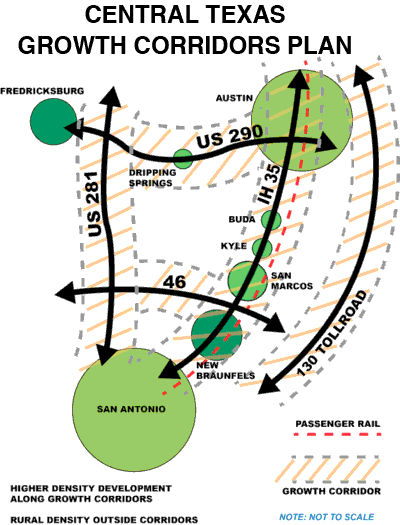HAYS COUNTY TRANSPORTATION
Growth Corridors Plan
Since early 2012, Citizens Alliance for Responsible Development has gone on record several times in support of a Hays County Transportation Growth Corridors Plan that would greatly benefit business, growth and development, while preserving some of the natural heritage and beauty that has drawn people to Hays County for more than 200 years. The plan recognizes the reality of citizen’s inability and unwillingness to pay ever higher taxes for unneeded, unwanted and unsustainable road development. It would also help prevent a potential water calamity that would certainly occur if the already water-stressed central Hays area is rapidly over-developed.
The plan is based on recognizing and encouraging focused development where there is already existing infrastructure and natural as well as growth-based resources. A combination of factors have already established four Growth Corridors, which roughly form a square of vigorous business, residential and highway development around the still essentially natural center of the county.
This square is formed by;
- On the east, Interstate 35, running from Austin through Buda, Kyle, San Marcos and New Braunfels, then on south to San Antonio, which will be further reinforced by growth along the new Texas Highway 130 Toll Road that parallels I-35 on the east;
- On the north, by US 290 going west from South Austin to Dripping Springs and ultimately on toward Johnson City and Fredericksburg;
- On the west by US 281, running south from Johnson City through Blanco and on past State Hwy 46 to San Antonio and;
- On the south by Texas 46, going east-west from New Braunfels to US 281, above the booming north edge of San Antonio.
Many factors, some long-established and some recently created by growth, have made this plan both practical and essential:
- The cost of transportation is rising dramatically with gas and diesel approaching $4 per gallon. Energy costs will continue to rise
- The cost of land for Right of Way is very high in the scenic Hill Country of central Texas.
- Citizens, feeling the pinch of a troubled economy, are fighting back against more taxes.
- The county’s economy cannot support a huge road infrastructure with the ever-growing cost of tax-supported bonds floated to pay for roads. What roads are planned must be designed and built to serve only the expected need, not grossly overbuilt for projections that burden the actual taxpayers present today.
- In many areas of central Texas the population is aging, which will result in fewer vehicle miles traveled. This trend is occurring nationwide with a steady reduction in vehicle miles traveled overall.
- Younger people and families are tending to move away from the suburbs to more affordable urban environments with more amenities, where travel distances are shorter and housing is closer to jobs, friends, and activities.
Any plan for Hays County should look beyond the borders of the county to consider the larger region. We believe that the cities, the counties, and the state should focus their limited transportation resources on growth corridors where current infrastructure can be expanded, where mobility is most needed, and where high-capacity transportation networks already exist. In the Hays County area of central Texas the growth corridors, based on the previously mentioned routes, are:
- IH 35, approximately five miles on both sides of the freeway.
- US 281, approximately three miles on both sides of the highway.
- US 290, approximately five miles on both sides of the highway.
- Texas State 46, in Comal County, approximately three miles on both sides of the highway.
- Hwy (Toll Road) 130 approximately five miles on both sides of the highway.

Conceptual map of the growth corridors
|
Those growth corridors and the roads within these corridors should be apportioned the bulk of the transportation dollars. That is where growth can be accommodated efficiently and transportation costs kept within the means of the already over-burdened taxpayer. For years the Texas legislature has refused to raise gas taxes, while the operators of cars and trucks have contributed less per mile to the road fund.
Taxpayers are going to be very hesitant to approve any additional road bonds for transportation projects. Area officials must learn to live within their means by using existing or even reduced funds in their transportation planning. This means that grand plans for major roads outside the growth corridors must be shelved. Plans for new road bonds and tax increases must also be dropped.
Within the Hill Country portion of Hays County and northern Comal County the terrain is rocky and hilly, creek and river crossings are numerous, and road building costs are excessive. Therefore the existing roads will have to do for now and into the future with only needed safety improvements and intersection widening, where justified.
Fortunately, that is what many visitors to and residents of central Hays and northern Comal Counties find so attractive – roads with slower speeds and beautiful scenery that provide adequate access for daily trips and commerce. Within these central areas of the counties the primary expenditure of roadway dollars should be on proper maintenance of the roads and early acquisition of Right of Way where selective intersection widening may be expected in the future.
This approach to transportation planning for our collective future recognizes the reality that growth projected for central Texas will be attracted to areas where water, sewer, and transportation infrastructure is already in place and where mobility improvements can be efficiently and economically developed – the growth corridors. It also recognizes that with changing demographics, higher energy costs, resistance to new taxes, and new trends in urban-oriented housing, the conditions that led to successful rapid growth in the past are not likely in our future. Additionally, in central Hays and northern Comal Counties the primary water supply source, the Trinity Aquifer, will be unable to provide adequate drinking water for intensive development; thus, maintaining a rural development density will be essential to the area’s future.
|

